The winding road to science journalism Inspire article
Originally, Nadia Salem wanted to become a research biologist and find a cure for cancer. Today, she is a reporter for Nano, a daily science magazine on German-language TV. Nadia talked to Marlene Rau about the unpredictability of life and the joys of being a science journalist.
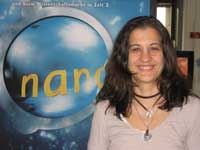
Image courtesy of Marlene Rau
Nadia has been interested in biology, and anatomy in particular, from an early age: “We used to have dogs when I was little, and I liked to run to the butchers to fetch them the cows’ hearts that we fed them, because I was intrigued by the course of the blood vessels. I also enjoyed dissecting frogs or any other dead animals I could find.” Her dearest memories from school are of teachers who were passionate about their subject, and whose enthusiasm was contagious. The biology lessons she remembers best are those in which teachers either took the class on a field trip or let them do hands-on experiments. And such an experiment can be simple – just dissecting an earthworm and starting to understand how all body parts are assembled can be extremely fascinating.
It was clear Nadia would go on to study biology or medicine. Being a true Bavarian girl, she only managed to move 125 km, from Munich to Bavarian Regensburg, a university town famous for its medieval centre, to study biology. “This is really the life science. You learn all the basics, from amoebae to humans and up to medical aspects. We had a lot of chemistry, physics and mathematics classes, too, and you start to understand how it all fits together. It was really rewarding, learning something about and for life.”
Nevertheless, you decided not to work as a scientist. When did things change?
“The disillusionment started when I realised that I found it all very tedious, really. You do experiments all day, and mostly go home with no results. Being a scientist sounds so exciting, when you look at the results, but getting there takes a lot of detailed painstaking work and you really have to specialise. I wanted results at the end of a day or week, not after years, so I decided I was not cut out to be a scientist. It was hard, after five years of studying, to admit to myself I did not really want to work as a biologist. I had to learn to separate my fascination for science from actually being a scientist, and found that there are other ways to work with science. It was not all bad, because I started asking myself what other talents I had which I was not using. These were a knack for communication, a quick grasp of things, and a love for telling stories.”
So science journalism was the obvious choice?
“My boyfriend said I should try journalism, since I talk all day anyway. Additionally, a friend of mine, who is now also part of the Nanow1 team, was studying journalism at Mainz Universityw2. It sounded so cool that I wanted to go too. I have never once regretted it.
“There is something I would like to tell all young people: never let anyone discourage you from something you really want. Be brave and do not be afraid to take a side road in life or start something new. You will always learn something, for example ‘soft’ skills: dealing with people, structuring a project or simply being proud of having achieved something. To most employers, your personality and motivation are at least as important as your career path. So have the courage to be original and do not always assimilate to the rest.”
What was studying journalism like?
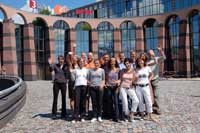
broadcasting center in Mainz
Image courtesy of Nano
“At Mainz University, graduates of any other subject can do a two-year master’s degree in journalism. There is an admission test, and only about 25 people are admitted each year. The first year was dedicated to print and online media, the second to radio and TV. Learning groups are very small, and you are expected to work in your spare time – in the media, if possible.
“I got my first job only a month into studying, in the newsroom of a sports programme at the ZDFw3 (Zweites Deutsches Fernsehen, a publicly funded national German TV station, located in Mainz). We also had to do internships – and I tried to choose the ‘best ofs’, starting out at the dpaw4 (Deutsche Presse-Agentur, the biggest German press agency) to get an idea of how the original sources work, and then went on to do audiovisual work. I never worked for print media because I knew that was not my cup of tea, but I found both radio and TV attractive. Eventually, since my first job was in TV, this is where I ended up.”
What does it take to be a science journalist and what do you like about it?
“Basically you act as a translator: so many interesting but complex things happen in science, and someone needs to break them down for the public to understand. Of course, first I have to understand them myself, since I, too, know next to nothing about some areas of science. Being curious is important, but you also need a sixth sense for knowing which science stories are worth telling. Besides making science intelligible, you also have to highlight the connections, make it interesting and exciting, engage the public, and tell a good story.
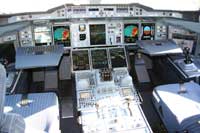
Image courtesy of Naddsy; i
mage source: Wikimedia Commons
“The best part for me is that you get to meet all kinds of interesting people, and see and do things you would normally not have access to. Being a TV journalist opens doors. I have witnessed brain operations in the operating theatre, sat in the cockpit of an Airbus A380w5 (the biggest commercial aircraft ever) – these experiences are very rewarding.”
What does a working day look like for you?
“This week I am on news duty – there is a rota. You go through the agency news in the morning, then you find corresponding footage in the archives or maybe send out a team to shoot something up-to-date, edit the video sequences and prepare the text for the voice-over, which is done by a professional speaker. You produce a 1:30 minute clip to be ready by 2 pm, and if anything exciting happens during the day, there can be last-minute changes. It can get a bit hectic.
“Normal everyday work – unlike news duty, which the reporters have to do about every three or four weeks, can look very boring from the outside. First you have the research phase, where you sit at your desk, search for information on the web, phone people and put things together. You find a topic, try to get a picture of the details involved, write a script, prepare and organise everything. You have to find the right people, the locations, and so on.
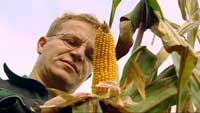
excerpt from a Nano broadcast
Image courtesy of Nano
“One of my current topics is genetically modified (GM) sweetcorn, since it is now allowed to be sown in Germany. I am trying to find an ideal setup of two people – a farmer who wants to use GM sweetcorn and who is the neighbour of an organic farmer. I want to see how they deal with it, with their different fears: the organic farmer who does not want his crops contaminated, and the GM farmer who is afraid that his crops will all be ruined by some pest – and therefore wants to use GM sweetcorn. We will use this framework to explain what GM sweetcorn actually is, whether you need to be afraid of it, and also that the ecological consequences are not clear.
“When everything is set up, you go out to do the shooting, which is the nice bit. You meet the camera team and the people being filmed, and try to convert your idea of the story into a nice film. As a reporter on location, you have to be a multitasking entertainer: if you go to a hospital, say, for a story on a new cure, the doctor will keep telling you complicated things, you have to make sure that the patient is physically and emotionally comfortable, the press officer will probably be there, then somebody from another department will turn up who also has a great idea for TV – you really need to have huge ears and eyes to communicate with everyone. And of course you have to keep an eye on the work of the camera team. You have to fulfil everyone’s need for information, without forgetting to check everything is done correctly and on schedule. You also have to be a bit of a psychologist, to put people at ease who may be shy in front of the camera, or to tell a worried doctor you will cut out embarrassing things he may have said or done. Although it looks as if the cameraman is doing all the work, it can actually be quite exhausting for the reporter, too. And then there are of course the days when nothing works – the train is late, the doctor is ill, the cameraman is in a bad mood – so you need to have some talent for improvisation, too.
“We usually make people the focus of our science stories. It is wonderful to meet all sorts of people and get a snapshot of their lives. Sometimes you see tragic stories, too – there was this guy in his mid-thirties, just two years older than me, who used to be a workaholic. Now he is paralysed, but fully conscious, suffering from a disease with no cure. To see that this can happen to someone your age, from one day to the next, really hits you and puts things into perspective. To see how such people cope inspires a lot of respect in me. Nevertheless, they are still just part of your work, rather than your life.
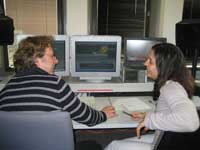
Matthias Stein in the cutting room
Image courtesy of Marlene Rau
“Separating this is not always easy, though. But you have to be tough, even though it is hard – when the feature is done, it is done, and it was just another story. At least we are a respectable programme and we definitely try not to betray people’s trust. I try to console myself with the fact that if nobody were to report on this at all, no one would know, and that would not be good either, would it?
“After we have done all the shooting, we need to look through all the footage. Most people find this extremely boring and try to postpone it, but of course it has to be done. Editing the material, however, is much more exciting, although it is very labour-intensive: for one minute of final video material, you can expect to spend at least one hour sitting at the cutting machine. You give the directions, and the cutter does the technical bit. Of course they also contribute their own ideas and, importantly, they are your first audience – if they don’t understand the story, you have probably done something wrong.
When everything falls into place, and what you thought up in the planning phase actually works well, it is just great. As a last step, there is the voice-over, and at the end, you have a finished feature to be broadcast.”
What are your suggestions to anyone interested in becoming a science journalist?
“I think science journalism is booming. Every German TV station has its own science programme, but of course they are of different qualities and aimed at different audiences. I think people really want to know and understand, and the world is getting more and more complicated. So there is definitely a market, and I think it is a job for the future. Not only on TV, but also in other media and elsewhere: a press officer at a car company, for example, needs to be able to explain how a hydrogen engine works nowadays.
“I would advise anyone who wants to become a science journalist to first study a science – whichever science suits you best. It gives you an insight into the way scientists work, which you could never have otherwise. And while I of course do not remember the details of everything I learned, it is very valuable to have understood the basic principles. Nevertheless, I also know good science journalists who have never studied science – they were just always interested in the topic. Sometimes this may even be an advantage, because it is easier to step back and simplify a topic you are not too close to. But I personally find it very helpful to have studied biology.”
What are your own plans for the future?
“I think I will continue to work as a TV science journalist for a while – I really like my job. Additionally, I oversee Mainz Campus-TVw6, a university TV station run by students of all subjects, and I teach TV journalism to the master’s students. I really enjoy that. Last year I also gave media training to scientists at the university. I didn’t expect it to be so much fun! I first thought I would be able to tell them nothing interesting, but it turned out I did know many things that were useful to them. All they wanted to know was how to react when a reporter turns up and asks questions: what to tell them, how far to simplify, and things like that. Obviously, this is something I deal with every day, standing on the other side of things, thinking ‘Gosh, can’t you speak straight and stop using foreign words for once?’ So this is another thing I would like to follow up on. And then, who knows? When I was 20, I would never have thought I would end up as a TV reporter, and yet 18 years later, here I am.”
Nano and the Nano-Camp
Nanow1 is a daily science programme on 3satw7, a German-speaking TV station in Mainz that was founded in 1984 to broadcast cultural programmes. It is a publicly funded station, run by seven TV stations (German ZDFw3, Austrian ORFw8, Swiss SRGw9 and the regional TV stations of German ARDw10). Nano has been on-air since 1 December 1999 and was the first daily science programme on German publicly funded TV. A team of 20 people, many of them scientists, works in the newsroom at the ZDF campus in Mainz, where the programme is produced. Science journalists from all seven TV stations meet for a daily video conference to agree on topics, for which they all supply footage. Three moderators, two of whom are physicists, take turns in presenting the 30-minute programme. A lot of the footage can be watched online, in the 3sat ‘Mediathek’w11.
The ZDF campus can be visited free of charge, including a guided tour behind the scenesw12. Special tours can be organised for school classes. ZDF also offers short internships for girls between 10 and 15 as a part of Girls’ Dayw13, a national German initiative aimed at starting more girls out on a career in science and technology. ZDF is also a partner of the Mentorinnennetzwerk für Frauen in Naturwissenschaft und Technikw14, a mentoring network for female school students interested in science, university science students, and young scientists, in the federal state of Hessen, Germany.
Since 2002, Nano has also organised the Nano-Campw15 every summer together with the Helmholtz Centre for Environmental Researchw16 (UFZ). This is a one-week science camp for 12 German, Austrian and Swiss students aged between 16 and 18 years, co-funded by Germany’s centre of expertise for science communication, Wissenschaft im Dialogw17, and the science journal Bild der Wissenschaftw18. The students can apply individually and are chosen for their motivation. They have the opportunity to conduct their own research and are presented on TV in Nano. In 2008, the year of mathematics, they used applied mathematics: in the UFZ location in Leipzig they modelled climate predictions. Additionally, they drilled ten metres deep into the soil of Bitterfeld, an East German town infamous for its chemical industry and the environmental consequences thereof, to find out which micro-organisms are decomposing the organic toxins. Since most terrestrial microbes are still unknown, this was cutting-edge research. Mathematics helped in the form of formulae and computer power, using the 3D-Cave – a virtual reality box – to visualise the invisible underground.
Web References
- w1 – For more information on the Nano TV science programme, see: www.nano.de
- w2 – For more information on the master’s of journalism degree at the Johannes-Gutenberg-Universität Mainz, see: www.journalistik.uni-mainz.de
- w3 – You can find the ZDF website here: www.zdf.de
- w4 – The website of dpa, the German press agency, in German, English, Spanish and Arabian, can be found here: www.dpa.com
- w5 – For more information on the Airbus A380, see: www.airbus.com/en/aircraftfamilies/a380
- w6 – To find out more about Campus-TV, the TV station run by students of Mainz University, see: www.campus-tv.uni-mainz.de
- w7 – The website of the German 3sat TV station, which produces Nano, can be found here: www.3sat.de
- w8 – For more information on the Austrian TV station ORF, see: www.orf.at
- w9 – The website of Swiss TV station SRG can be found here: www.srg.ch
- w10 – This is the website of German TV station ARD: www.ard.de
- w11 – To access the Nano Mediathek and watch footage online, go to the Nano websitew1, then click on ‘Mediathek’ in the top bar
- w12 – To organise a visit to the ZDF campus in Mainz, see: www.zdf.de/ZDFde/inhalt/20/0,1872,2001332,00.html
- w13 – To find out more about Girls’ Day, see: www.girls-day.de
- and to organise an internship on Girls’ Day at the ZDF, send an email to gleichstellung@zdf.de
- w14 – For more information about the female mentoring network Mentorinnennetzwerk für Frauen in Naturwissenschaft und Technik, for girls and women in Hessen, see: www.mentorinnennetzwerk.de
- w15 – For more information on the Nano–Camp, including a wealth of videos, see: www.3sat.de/nanocamp
- w16 – The website of the Helmholtz Centre for Environmental Research can be found here: www.ufz.de/index.php?en=11382
- w17 – To find out more about Germany’s centre of expertise for science communication, Wissenschaft im Dialog, see: www.wissenschaft-im-dialog.de/en/about-us.html
- w18 – The website of the science journal Bild der Wissenschaft can be found here: www.bdw.de
Review
Students always assume that science means bench work, which it does initially, but there is so much more that you can do once you have a science degree. This article describes one pathway for forging a career in science journalism. Many students are fascinated by science but, like Nadia, find the reality at the bench tedious. Journalism is a varied job requiring good background knowledge in science and the ability to work to tight deadlines. This could be an ideal career for those well-disciplined students who both like and are good at writing or presenting science and have good interpersonal skills.
Shelley Goodman, UK





